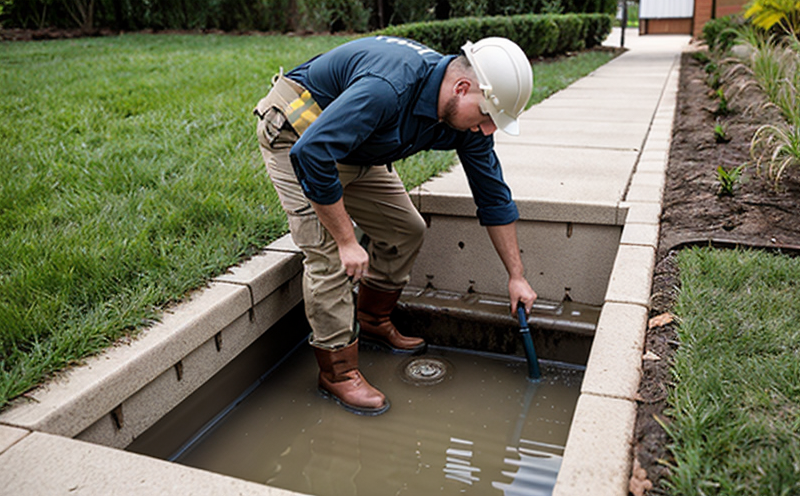Drainage system inspection
The integrity and functionality of drainage systems are critical to ensuring the safety and sustainability of buildings. Properly designed, installed, and maintained drainage systems prevent water accumulation, mitigate risks associated with sewage backups, and contribute significantly to a building's overall environmental performance. This service focuses on comprehensive inspections aimed at identifying potential issues before they escalate into costly repairs or health hazards.
Drainage system inspection encompasses both external and internal checks that cover various elements such as downspouts, gutters, sump pumps, lateral lines, and main sewer connections. The primary goal is to assess the condition of these components in relation to their intended function within the building's structure. This service ensures compliance with local building codes and industry standards while providing actionable insights for ongoing maintenance.
In the context of construction projects, early identification of deficiencies allows contractors to address issues promptly during the build phase rather than dealing with more extensive problems post-occupancy. For existing buildings, regular inspections help extend the lifespan of drainage systems, thereby reducing long-term operational costs and environmental impacts. The expertise involved in this service draws from multiple disciplines including plumbing engineering, structural analysis, and environmental science.
Inspection methodologies vary depending on the specific areas being assessed but generally involve visual examinations supplemented by advanced tools like cameras inserted into pipes to capture detailed images of interior conditions. Additionally, pressure testing may be conducted to evaluate pipe integrity under simulated real-world conditions. These tests provide valuable data points about the overall health of the drainage system which can then inform remediation strategies.
Understanding the importance of regular inspections cannot be overstated; they serve as a preventive measure against costly failures and promote sustainable practices throughout the lifecycle of any given facility. By leveraging this service, stakeholders gain assurance that their properties meet regulatory requirements while also enhancing occupant safety and comfort levels.
Scope and Methodology
| Aspect | Description |
|---|---|
| Type of Inspection | Preliminary site survey, visual inspection, internal camera inspection, hydrostatic testing. |
| Tools Utilized | Video cameras, manholes, sewer cleanout devices, pressure gauges. |
| Testing Parameters | Flow rates, water levels, blockages, corrosion levels. |
| Reporting Criteria | Detailed report including findings and recommendations for corrective actions. |
The scope of our drainage system inspection service includes a thorough examination of all key components that make up the building's drainage network. Our team begins by conducting a preliminary site survey to understand the layout and configuration of the existing systems. Following this, we perform visual inspections both internally within pipes and externally around structures where necessary.
For more detailed assessments, advanced tools such as video cameras are used to penetrate deeper into hard-to-reach areas providing clear images that allow for precise diagnosis of any potential issues. Hydrostatic testing is also carried out if required by local regulations or deemed necessary based on preliminary findings. This process involves applying controlled amounts of water pressure to the system to check for leaks and ensure proper functionality.
The collected data serves as the basis for generating comprehensive reports which summarize our observations along with suggested remediation plans tailored specifically towards addressing identified shortcomings. These documents serve not only as evidence of compliance but also offer valuable guidance for future maintenance activities ensuring prolonged service life from your drainage infrastructure.
Why Choose This Test
- Promotes early detection of issues that could lead to significant damage if left unaddressed.
- Ensures adherence to relevant local, national, and international standards including AS/NZS 3500.4:2016 for plumbing systems.
- Improves overall building performance by enhancing water management efficiency.
- Reduces risk of health hazards such as mold growth due to poor drainage.
- Prolongs the useful life of your property's drainage infrastructure through preventive maintenance recommendations.
- Facilitates easier compliance with regulatory requirements reducing potential fines or penalties.
- Provides peace of mind knowing that expert professionals are regularly monitoring and maintaining critical elements of your facility.
Selecting this inspection service offers numerous benefits beyond mere compliance. It allows property owners to make informed decisions about necessary improvements based on factual evidence rather than guesswork. Furthermore, it fosters a culture of proactive management which is essential for long-term success in any real estate portfolio.
International Acceptance and Recognition
The importance of reliable drainage systems extends globally, with many countries adopting similar standards to ensure consistent quality across different regions. For instance, AS/NZS 3500.4:2016 provides guidelines specifically for plumbing systems which include detailed instructions on how to conduct comprehensive inspections like those offered here.
International organizations such as ISO (International Organization for Standardization) and ASTM International also contribute significantly towards standardizing practices worldwide. Compliance with these standards not only enhances credibility but also opens up opportunities for broader market penetration since it demonstrates adherence to universally accepted benchmarks.
By choosing our service, you are aligning yourself with globally recognized best practices in drainage management. This recognition can be particularly advantageous when dealing with international clients or partners who expect a certain level of proficiency and expertise from vendors operating within their jurisdictions.





